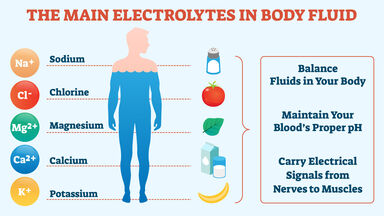Electrolytes aren’t the reason your body can operate but do help it run smoothly. Like a battery in a car, these minerals found in your blood and other body fluids trigger voltages that carry electrical impulses – in the kind of nerve nerves as well as muscle contractions – across your cells.

This electrical energy keeps your organs working properly. Electrolytes can help ensure the optimal performance of your digestive, nervous muscular, and cardiac systems. We will now cover fundamental aspects like how your body regulates electrolytes. We will also discuss indicators that indicate you are suffering from electrolyte imbalances, and the most important part, how to replenish the electrolytes you’ve lost.
The body’s ability to regulate electrolytes
The kidneys of your body are the center of electrolyte monitoring. They track changes in your body from shifts within electrolyte concentrations.
Intense exercise is the most commonly used method to deplete electrolytes. The higher the temperature and more vigorous your exercise, the more water is lost.
In the words of the American College of Sports Medicine, The average person loses about 2 to 6 percent of their body weight during exercise sessions as sweat is released.
Another reason for electrolyte loss occurs in the case of chronic vomiting or diarrhea. The fluids need to be replenished in order to avoid dehydration, and also to keep vital bodily functions functioning properly.
If you’re the type of person who is a fervent exerciser do a vigorous exercise program. Also, if you are suffering from a medical condition that demands constant monitoring of your liquid intake and exercise. Edrea Jones, M.D. a nephrologist, recommends talking to your physician to know your limits and water requirements.
“Staying hydrated is key to proper body function,” says Dr. Jones.
Signs of an imbalance of electrolytes
When the amount of electrolytes in your body is too either too high or insufficient, you can develop:
- Dizziness
- Cramps
- Heartbeat irregularity
- Mental confusion
- The most frequent sign of low electrolytes is muscle cramping. This can be extremely painful and debilitating.
Maintaining electrolyte levels
The best way to maintain electrolytes levels in your body is by paying attention to your thirst. Dr. Jones recommends drinking about two cups of fluid two hours prior to any exercise. In the meantime, drink 4 to 6 ounces each between 15 and 20 minutes during your physical activities. And lastly, drink a recovery drink after you have finished exercising.
How can you replenish electrolytes?
Hydration is crucial to keeping electrolytes in balance. Water is the most natural choice for getting hydrated. It’s not as expensive and has more accessibility than other drinks. Coconut water can be a good alternative for replenishing electrolytes. Coconut water is low on the glycemic scale, consequently, it won’t drastically alter your blood sugar levels. It has also been proven by studies that it may aid in reducing blood pressure and cholesterol -and is, therefore, a healthy reason to drink it.
However, sports drinks are often more appealing. Sports drinks contain electrolytes and carbohydrates that help to replenish body energy. A lot of sports drinks contain calcium chloride or sodium chloride as an ingredient, which are major electrolytes that are lost during exercise. The sugar and flavor of these drinks can entice people to drink an increased quantity compared to water.
Drinks to stay clear of
Drinks that contain carbonated soft drinks, juices of fruit, and energy drinks should all be avoided for drinking as hydration sources. They are loaded with sugar and empty calories. The carbs present in these drinks are brief bursts of energy, rather than long-term benefits. “Staying well-hydrated benefits our bodies in so many intricate ways,” says Dr. Jones. “Our bodies are extremely complex, and water is the center of our lives that we cannot do without. This is the reason why no one can stay for more than three to five days without any water intake.”

